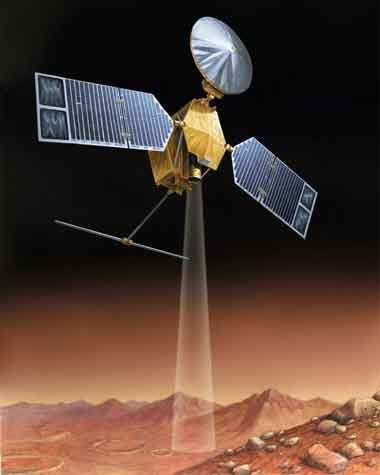73 Terabits Of Data Sent From Above Red Planet
NASA's Mars Reconnaissance Orbiter has completed its primary,
two-year science phase. The spacecraft has found signs of a complex
Martian history of climate change that produced a diversity of past
watery environments.

The orbiter has returned 73 terabits of science data, more than
all earlier Mars missions combined. The spacecraft will build on
this record as it continues to examine Mars in unprecedented detail
during its next two-year phase of science operations.
Among the major findings during the primary science phase is the
revelation that the action of water on and near the surface of Mars
occurred for hundreds of millions of years. This activity was at
least regional and possibly global in extent, though possibly
intermittent. The spacecraft also observed that signatures of a
variety of watery environments, some acidic, some alkaline,
increase the possibility that there are places on Mars that could
reveal evidence of past life, if it ever existed.
Since moving into position 186 miles above Mars' surface in
October 2006, the orbiter also has conducted 10,000 targeted
observation sequences of high-priority areas. It has imaged nearly
40 percent of the planet at a resolution that can reveal
house-sized objects in detail, 1 percent in enough detail to see
desk-sized features. This survey has covered almost 60 percent of
Mars in mineral mapping bands at stadium-size resolution. The
orbiter also assembled nearly 700 daily global weather maps, dozens
of atmospheric temperature profiles, and hundreds of radar profiles
of the subsurface and the interior of the polar caps.
"These observations are now at the level of detail necessary to
test hypotheses about when and where water has changed Mars and
where future missions will be most productive as they search for
habitable regions on Mars," said Richard Zurek, Mars Reconnaissance
Orbiter project scientist at NASA's Jet Propulsion Laboratory in
Pasadena, CA.
Included in the observations are hundreds of stereo pairs used
to make detailed topography maps and classic images in support of
other Mars missions. One image showed the Mars rover Opportunity
poised on the rim of Victoria Crater and another of NASA's Phoenix
Mars Lander during its descent to the surface. Orbiter data
prompted the Phoenix team to change the spacecraft's landing site,
and are being used to select the landing location for NASA's Mars
Science Laboratory, which is scheduled for launch in 2011. For five
months of Phoenix operations on Mars that ended in November, the
Mars Reconnaissance Orbiter and NASA's Mars Odyssey orbiter shared
the vital communications roles of relaying commands to the lander
and data from Phoenix back to Earth.
The Mars Reconnaissance Orbiter has found repetitive layering in
Mars' permanent polar ice caps. The patterns suggest climate change
cycles continuing to the present. They may record possible effects
of cyclical changes in Mars' tilt and orbit on global sunlight
patterns. Recent climate cycles are indicated by radar detection of
subsurface icy deposits outside the polar regions, closer to the
equator, where near-surface ice is not permanently stable. Other
results reveal details of ancient streambeds, atmospheric hazes and
motions of water, along with the ever-changing weather on Mars.
Most observations from the orbiter will be discontinued for a
few weeks while the sun is between Earth and Mars, which will
disrupt communications. In December, the orbiter will begin a new
phase, with science observations continuing as Mars makes another
orbit around the sun, which takes approximately two Earth
years.
"This spacecraft truly exemplifies the best in capabilities to
support science and other Martian spacecraft activities," said
Michael Meyer, lead scientist for the Mars Exploration Program at
NASA Headquarters in Washington. "MRO has exceeded its own goals
and our expectations. We look forward to more discoveries as we
continue to look at the Red Planet in spectacular detail."

NASA's Jet Propulsion Laboratory in Pasadena manages the Mars
Reconnaissance Orbiter for NASA's Science Mission Directorate,
Washington. Lockheed Martin Space Systems, Denver, is the prime
contractor for the project and built the spacecraft.
 Sierra Space Repositions Dream Chaser for First Mission
Sierra Space Repositions Dream Chaser for First Mission ANN's Daily Aero-Term (05.10.24): Takeoff Roll
ANN's Daily Aero-Term (05.10.24): Takeoff Roll Aero-News: Quote of the Day (05.10.24)
Aero-News: Quote of the Day (05.10.24) Aero-News: Quote of the Day (05.11.24)
Aero-News: Quote of the Day (05.11.24) ANN's Daily Aero-Term (05.11.24): IDENT Feature
ANN's Daily Aero-Term (05.11.24): IDENT Feature




